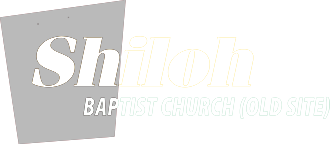Introducing George Rowe, the white preacher/overseer whose “stern resolve” created a stony road to be traversed by this congregation during the years before the Civil War
This information was gathered and prepared by the History and Archives Committee of Shiloh Baptist Church (Old Site) in Fredericksburg, Virginia. At the time of its initial compilation, the committee consisted of Janice P. Davies, Bernice Easley, Faye Jones, Roland Moore, Mark W. Olson, and Dee Simmons. Numbers in brackets refer to source notes, found at the end of this report.
During the years prior to the Civil War, it was often difficult for people of color in the Fredericksburg area to attend Sunday church services. Many had to work on Sundays. And even if they weren’t working, the enslaved couldn’t go anywhere on Sundays — or any other day — without carrying or wearing a pass from their “owner.”
In addition, by law in those days, a white overseer was required whenever people of color held a church service or other gathering together. It’s not clear who initially provided this oversight. But we know that George Rowe, an ardent opponent of abolition, served as our legally required pastor/overseer for the last five years before the Civil War.
According to newspaper accounts, it was 1857 when George Rowe, a self-educated white Fredericksburg resident took over the task on an ongoing basis, becoming the Black congregation’s legally required pastor/overseer. [1]
Rowe lived about a half mile from Shiloh, higher up on Hanover Street. Born January 1, 1793, he moved to Fredericksburg about 1818 and “immediately identified himself with the business men and business interests of the city.” [2] According to newspaper reports after his death, he was known as a person with “a clear head, an honest heart, and an ambitious spirit” and as someone who was “animated by a stern resolve for self-elevation.” [3]

Prior to the Civil War, George Rowe, a man ardently opposed to the abolition of slavery, was appointed to serve as our legally mandated white pastor and overseer. He served for five years — until the arrival of Union troops near Fredericksburg.
Shortly after moving to Fredericksburg in the early 1800s, George Rowe had professed religion. As a result of his religious inclination, he aligned himself with what was then a racially diverse Baptist congregation, a church that was just beginning to make the transition from its original location (near the current railroad station) to a new location on the banks of the Rappahannock River at what is now 801 Sophia Street. [4]
Although George Rowe became an early member of that racially diverse congregation, he had not the slightest doubts about the continued practice of human enslavement. Not only was he himself a slave owner, but he allied himself beginning by at least 1835 with the city’s vocal anti-abolition movement. [5] He attended meetings and voted to approve long and vigorous resolutions condemning those allegedly false Northern preachers who had “studiously perverted and profanely invoked…the sacred precepts of religion” by seeking the speedy abolition of slavery. [6]

During the years that George Rowe served as our pastor/overseer, this building at Charles and Frederick streets (now a private residence) served as a slave jail. It was here that Fredericksburg’s principal slave trader, a man named George Aler, held his human “cargo.“
George Rowe also served on a twenty-member “vigilance committee” that was appointed to “aid the civil authorities in detecting and bringing to justice the abolitionists, their agents, and emissaries who may be engaged in disseminating their nefarious publications and prosecuting their incendiary projects” in the Fredericksburg area. [7] This same group urged a vigorous enforcement of the laws, pledging themselves to aid the police in bringing to punishment “the editors and distributors of anti-slavery papers and the preachers and teachers of their doctrines. [8]
A newspaper reporter described George Rowe’s religious behavior as displaying “the same stern conscientiousness and unremitting attention which had characterized his secular conduct.” [9] At an early date, he was elected as a deacon in the largely Black but white-dominated Baptist congregation. Later he advanced to the post of an “exhorting” (or preaching) deacon. Finally, at the age of 58 in 1851, he retired from his business activities and was ordained by the Baptist congregation as a “minister of the gospel.” [10]

Prior to the Civil War, this auction block, which stood until early 2020 at the corner of William and Charles streets, was well-known to early members of Shiloh, for it was where many of Fredericksburg’s enslaved human beings were either bought or sold.
As a newly ordained minister, George Rowe initially had no fixed charge. He preached or presided in various Baptist churches in the surrounding counties before finally serving for several years as pastor at Spotsylvania’s Salem Baptist Church. [11] In 1857, he was appointed as the pastor/overseer of the Black segment of his former Fredericksburg congregation, which was often described by local white folks as “the African Baptist Church.”
In late November of 1857, the Reverend George Rowe baptized eighteen new members of his congregation in the undoubtedly chilly Rappahannock River. At that time, he reported to the local press that the Black congregation’s membership was in excess of 700 individuals. [12]
Within five years, however, the outbreak of the Civil War had had a monumental effect on the congregation. When Union troops arrived in the area in 1862, more than half of the congregation fled the degradation of slavery and racial discrimination that had prevailed in Fredericksburg. city to occupy free areas to the north.
At some point in 1862, due to the destruction of the city caused by the Civil War and Rowe’s own failing health, regular Sunday services were discontinued. [13]

In this 1863 view, Shiloh Baptist Church is about a third of the way from the right edge of the photo. It’s the relatively large two-story building just above the sloping bank of the river.
Rowe’s resignation as pastor/overseer took effect January 1, 1863, simultaneous with the formal declaration of Emancipation. [14] He died three years later on January 18, 1866. [15]
According to congregational records, during the period of time in which Rowe served as the official pastor/overseer, much of the actual preaching and spiritual direction was provided by the congregation’s own Black deacons. In fact, one of those deacons, the Reverend Armistead Walker, is described in early documents as “one of the first ordained colored ministers” in Virginia. [16] According to a letter written on December 7, 1855, held in the archives of the James Monroe Museum and Memorial Library in Fredericksburg, Armistead Walker and George Rowe shared the pastoral duties at Shiloh. [17]
A broader overview of the congregation’s history can be found here.
Source notes
[1] Fredericksburg, Virginia: The Fredericksburg Ledger, January 26, 1866 (page 3, column 2).
[2] Fredericksburg, Virginia: The Fredericksburg Ledger, January 26, 1866 (page 3, column 2).[3] Fredericksburg, Virginia: The Fredericksburg Ledger, January 26, 1866 (page 3, column 2).[4] Fredericksburg, Virginia: The Fredericksburg Ledger, January 26, 1866 (page 3, column 2).[5] Fredericksburg, Virginia: The Political Arena, September 22, 1935 (page 2).[6] Fredericksburg, Virginia: The Virginia Herald, September 23, 1935 (page 3, columns 3–5).[7] Fredericksburg, Virginia: The Virginia Herald, September 23, 1935 (page 3, columns 3–5).[8] Fredericksburg, Virginia: The Virginia Herald, September 23, 1935 (page 3, columns 3–5).[9] Fredericksburg, Virginia: The Fredericksburg Ledger, January 26, 1866 (page 3, column 2).[10] Fredericksburg, Virginia: The Fredericksburg Ledger, January 26, 1866 (page 3, column 2).[11] Fredericksburg, Virginia: The Fredericksburg Ledger, January 26, 1866 (page 3, column 2).[12] Fredericksburg, Virginia: The Fredericksburg Ledger, December 1, 1857 (page 2, column 2).[13] Fredericksburg, Virginia: The Fredericksburg Ledger, January 26, 1866 (page 3, column 2).[14] Ruth Coder Fitzgerald, A Different Story: A Black History of Fredericksburg, Stafford, and Spotsylvania, Virginia ([City not specified], Unicorn, 1979), 77.[15] Oscar Darter, The History of Fredericksburg Baptist Church, Fredericksburg, Virginia(Richmond, Virginia: [publisher not stated], 1960), 81.[16] John C. Diamond, Jubilee Jottings (Fredericksburg, Virginia: Shiloh Baptist Church [Old Site], 1914, only known copy in the archive files of Shiloh Baptist Church [Old Site]); and Brooks-Higgonbotham, “From Strength to Strength: The History of Shiloh Baptist Church of Washington, D.C.”[17] Letter from John Minor to Mary Minor Blackford, written in Fredericksburg, December 7, 1855, cited by Fitzgerald, A Different Story, 77.
Welcome to a spiritually empowered haven of hope
Since 1854, we at Shiloh have tried to manifest the spirit of Christ, faithfully serving others as God’s liberating and transforming word. We’re located at 801 Sophia Street, on the river in downtown Fredericksburg, Virginia 22401.

Our historic building on the river in Downtown Fredericksburg is badly in need of exterior repairs and renovations to protect our ability to continue serving as a beacon of hope for all who are in need of Christ’s love and grace. The cost of the work is likely to be in excess of $175,000. We invite you to contribute to this project. Specially designated online gifts can be entered by CLICKING HERE.




